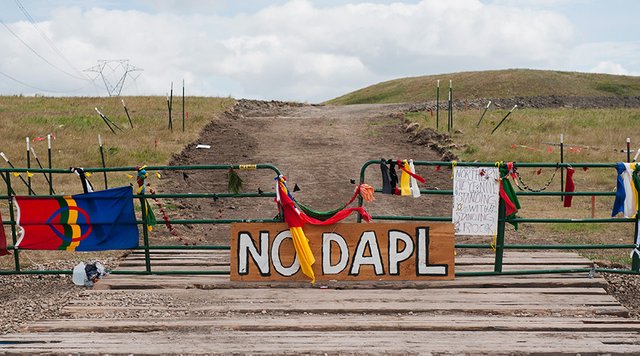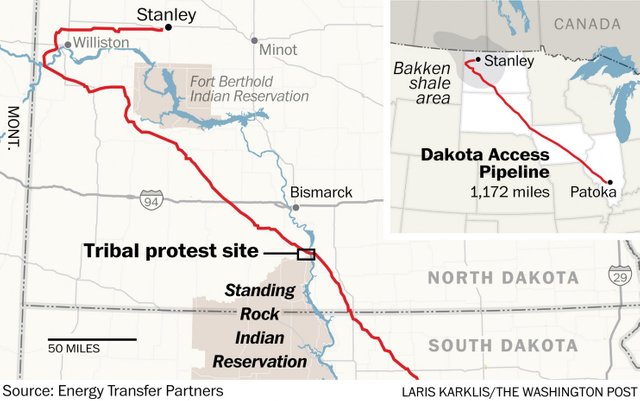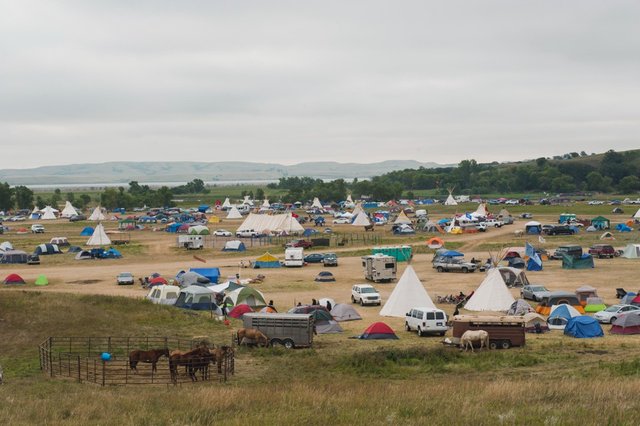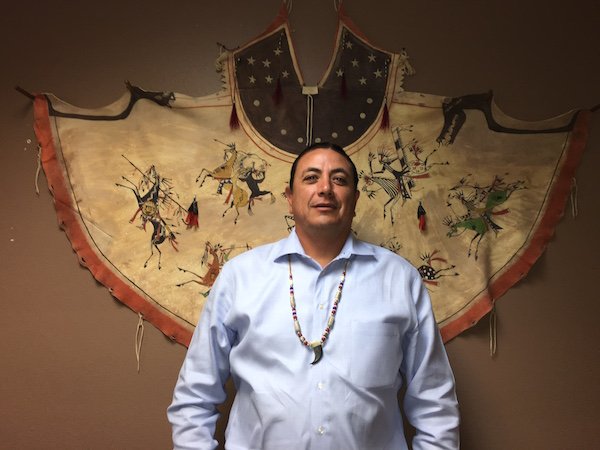A Sustainability Dialogue: The Dakota Access Pipeline and Subjugation of Native Americans
A familiar theme has reiterated itself in the United States since it's inception. The people and the government negotiate with one another, agreements are made, boundaries are set, and then promptly broken when the possibility of economic gain makes itself apparent. The latest such event has manifested itself in the protest of the Standing Rock Sioux Tribe against the Dakota Access oil pipeline (DAPL) that will cross directly over the tribe's sole water source as well as numerous sacred and ceremonial grounds. (Source)

The Dakota Access pipeline constitutes anti-sustainability action in two ways.
- First and foremost, oil pipelines such as these represent a definitive danger to environmental sustainability. The building of new oil infrastructure implies a focus on growing and expanding oil business and transportation as opposed to scaling back as the government has indicated in recent years that it is attempting to do. It is particularly ironic considering the United States just last week ratified the Paris Agreement, what many critics called some of the most ambitious environmental legislature ever written. (For more on the Paris Agreement, check out my previous post here.)
- Second, this pipeline is the opposite of sustainable relations with Native American groups, as well as more general sustainable citizen/government interaction, and continues a narrative of Native subjugation going back to the foundation of the country.
The Issue
- Dakota Access LLC, a subsidiary of Texas based Energy Transfer Partners, is attempting to build a 1,172 mile oil pipeline from the Bakken oil fields in North Dakota through South Dakota and Iowa and ultimately to Patoka, Illinois. (Source)

- The Standing Rock Sioux Tribe claims that the construction of the pipeline could desecrate sacred lands and numerous ceremonial sites. The pipeline would run less than half a mile away from the reservation. (Source)
- They further fear that, since the pipeline passes through the Missouri river just upstream from the reservation, any spill would completely destroy their water supply. The Missouri River constitutes their sole source of water. (Source)
- The tribe claims that the Army Corps of Engineers failed to include them in the planning process of the Pipeline as is legally required by federal law. Federal law states that
"regulations require Federal agencies to consult with Indian tribes when they attach religious and cultural significance to a historic property regardless of the location of that property” (Source)
- On the other hand, the US Army Corps of Engineers claims that it followed all due process.
- The company itself also maintains that the pipeline will be completely safe, and that it will be built to the highest standard and with the latest technology available.
Recent Events
Protesters have been camping out at sacred sites in Cannon Ball, North Dakota for months. While originally only a handful, the number of protesters has grown substantially in recent weeks and now there are hundreds. These protesters are native americans from all over the country, as well as human rights and environmental activists.

Camp of Protestors near Cannon Ball, ND - Source The Standing Rock Sioux sued the Army Corps of Engineers in July on the basis that their right to be consulted and included in planning had not been observed. The presiding judge, James Boasberg, ruled today that the tribe had not proved that the Army Crops of Engineers erred in its practices.

- Just hours ago, the US Department of Justice issued a statement that request the Corps of Engineers to temporarily halt all construction of the pipeline around Lake Oahe and anywhere within 20 miles of the area. However, this is only a small portion of the pipeline, and as of midnight tonight Dakota Access will be free to continue construction elsewhere. (Source) You can read the whole statement here.
- Tensions have started to boil over. On 9/3/2016, Dakota Access construction crew plowed through two locations that had the day before been identified by the tribe as sacred sites. When protesters tried to prevent the desecration, things got out of hand. The local sheriff's department are saying that the protestors escalated the situation and injured multiple private security guards and dogs, while the protestors say that a number of them were bitten and sprayed with pepper spray. You can see what happened for yourself in the video below. (Source)
Standing Rock Sioux Chairman David Archambault II called for calm and continued peaceful protest.
The pipeline threatens our sacred lands and the health of 17 million people who rely upon the Missouri River for water,” he said. “There is a lot at stake with the court decision tomorrow (referring to their attempt to halt construction of the pipeline). We call upon all water protectors to greet any decision with peace and order. Even if the outcome of the court’s ruling is not in our favor, we will continue to explore every lawful option and fight against the construction of the pipeline. Any act of violence hurts our cause and is not welcome here. We invite all supporters to join us in prayer that, ultimately, the right decision—the moral decision—is made to protect our people, our sacred places, our land and our resources. (Source)
The Silver Lining
While the actions taken by the US government and Dakota Access LLC have been upsetting to say the least, the publicity these events have won for Native Americans across the country is a silver lining. The whole country is watching to see how the government will handle this, and Dakota Access can do nothing without facing the judgment of the entire nation. It has also helped to unite a people who have been oppressed and actively subjugated for the past 200 years. As Archambault says,
We have maintained our culture. We’ve maintained our way of life. We’ve maintained our dignity. We’re still here. (Source)

That does not sound like a people ready to give up. And maybe, hopefully, this could lead to a future where the people of the United States stand hand in hand with Native Americans across the country to demand they be treated with the respect they deserve. And America might just learn something when that happens.
I believe that it is our duty as citizens to stand with the Standing Rock Sioux. Most of us may not be Native American, or even be particularly affected by the Dakota Access Pipeline. It might even be beneficial to some people. But it is times like these that I think about the poem written by Pastor Martin Niemöller.
Because I was not a Socialist.
Then they came for the Trade Unionists, and I did not speak out—
Because I was not a Trade Unionist.
Then they came for the Jews, and I did not speak out—
Because I was not a Jew.
Then they came for me—and there was no one left to speak for me.
Sources
- https://www.rt.com/usa/358846-dakota-pipeline-judge-ruling/
- http://www.npr.org/sections/thetwo-way/2016/09/09/493280504/judge-rules-that-construction-can-proceed-on-dakota-access-pipeline
- http://www.theatlantic.com/technology/archive/2016/09/dapl-dakota-sitting-rock-sioux/499178/
- http://www.achp.gov/regs-tribes.html
- https://www.justice.gov/opa/pr/joint-statement-department-justice-department-army-and-department-interior-regarding-standing
- http://abcnews.go.com/US/judge-rule-today-dakota-access-pipeline-case-protests/story?id=41973080
Steemians
We Can help
Sign The Petition @
Change.org
"Jo Ellen Darcy
Stop The Dakota Access Pipeline, Petition @change.org"
Visit
"RezpectOurwater.com"
We Can't Let This Happen In America
It doesn't look to me like the pipeline is on Indian...oh wait...I mean Native American...oh wait...I mean First Peoples...Oh wait...
I mean whoever-the-hell-you-call-them's property...
Okay, a number of reasons why this comment and the ones below dont make sense.
1- No, it technically does not run on their property. It runs half a mile next to their reservation and through their ancient sacred grounds. But guess what, they dont live where they used to because we have been stealing their land for 150 years. Many tribes live hundreds of miles from where they originated because they were systematically removed, killed, and relocated.
As you can see, the American government has redefined what Sioux territory means a number of times. Namely through wars like the Black Hills War in 1877 (when General Custer discovered gold in the Black Hills.) Also, this reservation is only where the American government put all Sioux native americans after Red Clouds War, which in turn was caused by American government land grabs. (Source)(Source)
2- The fact this is not the only pipeline in the United States has literally zero bearing on the arguments. The argument is that the pipe runs through sacred lands, which will require construction and digging that will desecrate those lands. Second, it runs directly upstream of the reservation of the Missouri River, the Standing Rock Sioux's only source of water. Any spillage would contaminate their water supply indefinitely. And it only runs at this Missouri River crossing because the original plan, which would cross the river just north of Bismarck (the capital of North Dakota) was scrapped because politicians in the city forced the move. So the native americans in the area are now stuck with it. (Source)
3- Railroad accidents has nothing whatsoever to do with the potential of oil spillage from the pipeline. We are not talking about how many people this pipeline will kill, but that any spillage at any time would destroy the water supply of the Standing Rock Sioux for a significant period of time. It doesn't matter how few and far between they are, if pipeline spillage here ever occurs, it is an issue. And the list you offered still shows an extensive number of spillages over the last 15 years.
4- Most importantly, this is about respect and following the law. When it comes down to it, it doesn't matter whether or not the pipeline is truly dangerous to the Standing Rock Sioux or the sacred spaces (which it is.) What it comes down to is that zero respect has been paid to these people whose lives are being affected by the government (who are supposed to work for the people), and that they were not consulted properly as the law requires. US law that requires native americans to be consulted and included in any construction planning on or near ancestral lands
Government lies.
Wow...didn't know that.
from my reading the ancient sioux didn't subscribe to the idea of property rights. They were nomads. They followed the buffalo. Suddenly they have "land'? Imagine that.
Who Knows?
What Concerns Them as well
is the Water
From What I gather,
This Construction Will Put
The Access Pipeline under Water
it Could Pollute The Missouri River
Geee...this is the first time a pipeline EVER crossed a river? This is a brand new thing?
My Question Is..
Is it Necessary?
Will Wait & See on This
For Now
The Construction has Been Halted
I'm certainly glad that Rail Road bridges don't go over the Missiouri River. According to the Federal Rail Road Administration the last year for which they had data indicated TOTAL ACCIDENTS/INCIDENTS: 5,047 Number of fatal accidents/incidents 406 as opposed to the number of pipeline incidents.. well...less than twenty in [2016]https://en.wikipedia.org/wiki/List_of_pipeline_accidents_in_the_United_States_in_the_21st_century)
There are twenty times more railroad accidents in a year than there are pipeline accidents in twenty years. So Naturally it wouldn't be wise to have a pipeline cross the river instead of (multiple) railway bridges.
oh wait...is that right?
Quote From Austin Dale on Facebook
So I still have friends on my page liking and sharing these anti-pipeline articles and memes. If you don't pipeline for a living, and you're not from North Dakota, South Dakota, Iowa, or Illinois then you should really stay out of this conversation, especially if you're just going to keep sharing the same lies over and over. I know everyone is entitled to their opinion, but this is not about opinions, it's about facts, and the facts are; the Dakota access pipeline DOES NOT cross the Standing Rock reservation, it DOES have all the necessary permits and approvals, and it is NOT disturbing any burial grounds This information is easily accessible online with a quick Google search, but I'll include a map anyway, in case you don't have time to research the lies you're sharing. And here are the links showing they have the permits, and that North Dakota's top archeologists surveyed these sites and found nothing. http://m.bismarcktribune.com/…/article_5dc1e955-fd71-5003-8…
http://m.kcci.com/…/archaeologist-no-human-remains…/41226410
And before you start in about possible water contamination, that's just another scare tactic. The Missouri river will be directionally drilled and the pipeline will have the latest technologies and monitoring systems to help prevent releases and will be constructed 90 feet below the riverbed to ensure nothing may reach the river — far above and beyond what’s required by federal regulations.
Don't be fooled, the battle right now may be against this pipeline, but the war is on oil. I know some of you hate oil (even though you consume as much as the rest of us on a daily basis) but there simply is not enough renewable energy to meet the current demand, so this oil WILL be brought to market one way or another, and the safest way is via pipeline. They have a smaller carbon footprint and are 4.5 times less likely to cause a spill than trains. It's an easy choice. So don't tell me you're against pipelines because you care about the environment, because the two ideas are contradictory.
End quote.
great stuff, I have been active in the #nodapl movement on twitter... it's never over... the battle continues... peace !